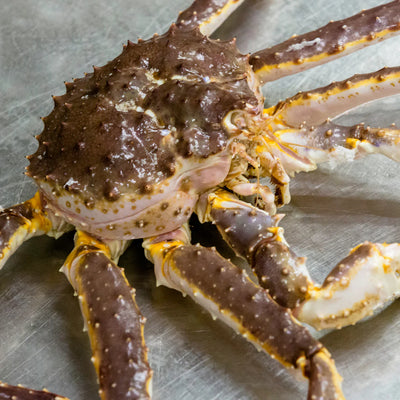The Journey of Live King Crab: From Ocean to Plate

Live King Crab: Ocean to Dining
Have you ever wondered about the journey behind the succulent king crab on your plate? Live king crab is not just a delicacy; it’s a marvel of nature and a testament to skilled harvesting and culinary artistry. From the icy waters of the northern Pacific to your dining table, the story of live king crab is as captivating as its taste.
As renowned chef Anthony Bourdain once said, “Good food is very often, even most often, simple food.” Live king crab embodies this simplicity, delivering unmatched flavor and freshness.
1. The Origins of Live King Crab
Where It All Begins
Live king crab thrives in the frigid, nutrient-rich waters of the northern Pacific Ocean, including the Aleutian Islands, the Bering Sea, and Arctic regions. These cold environments create the perfect conditions for these crustaceans to grow to impressive sizes.
The most coveted species, Alaskan Red King Crab (Paralithodes camtschaticus), is known for its spiny exoskeleton and long legs, which yield sweet, tender meat prized worldwide.
What Sets King Crab Apart
- Exceptional size and meat yield
- Rich, sweet flavor and delicate texture
- High nutritional value, including lean protein and omega-3 fatty acids
Learn more about the best-quality king crab at Global Seafoods.
2. The Harvesting of Live King Crab
The Art of Crab Fishing
Harvesting king crab is a challenging and dangerous task. Fishermen brave freezing temperatures and turbulent seas to capture these creatures during a short season, lasting only a few weeks.
- Crab Pots: Large, baited traps are lowered to the ocean floor, where they lure crabs into their cages.
- Selection: Only the finest crabs, meeting strict size and quality standards, are kept for market.
Sustainability Matters
To protect king crab populations, stringent regulations and quotas ensure sustainable harvesting. Fishermen follow size limits and seasonal guidelines to maintain this valuable resource for future generations.
“Sustainability is not just about protecting the species; it’s about preserving a way of life,” says the National Fisheries Institute.
3. The Journey from Ocean to Processing Facilities
Once harvested, live king crabs are swiftly transported to processing facilities to preserve their freshness.
Temperature-Controlled Storage
- Crabs are stored in tanks that replicate their natural ocean environment, maintaining optimal temperature and hydration.
- Proper storage ensures the crabs remain lively and flavorful until shipment.
Sorting and Selection
- Crabs are sorted by size and quality.
- Top-grade crabs are shipped live, while others are processed into frozen or cooked products.
4. Global Shipping: From Ocean to Market
The Shipping Process
Shipping live king crab is a delicate operation requiring precision and speed.
- Packaging: Crabs are placed in containers with temperature control and moisture retention systems.
- Transport: Most live king crabs are shipped via air freight, ensuring delivery within 24–48 hours.
Major Exporters of Live King Crab
- Russia: Kamchatka Peninsula’s Red King Crabs are renowned for size and flavor.
- Norway: Arctic king crabs from Norway are sustainably harvested and prized worldwide.
- Canada: Atlantic king crabs are a key export to the U.S. due to proximity.
- Alaska, USA: Domestic king crab from Alaska is a favorite among American seafood lovers.
Explore the finest Alaskan king crab options like Alaskan Red King Crab Legs and Golden King Crab at Global Seafoods.
5. Culinary Preparation: How to Enjoy Live King Crab
Top Cooking Methods
- Steaming: Preserves natural sweetness.
- Boiling: Ideal for large gatherings.
- Grilling: Adds a smoky flavor.
- Sautéing: Perfect for rich, savory dishes.
Recipe Idea: Garlic Butter King Crab
- Ingredients: Live king crab legs, garlic, butter, parsley, lemon.
- Instructions: Steam the crab legs, sauté garlic in butter, and toss with parsley and lemon.
For more cooking inspiration, visit the Global Seafoods YouTube Channel.
FAQs About Live King Crab
Q1. How is live king crab different from other crabs?
Live king crab is renowned for its large size, sweet flavor, and tender meat, setting it apart from other crab species.
Q2. Is live king crab sustainably harvested?
Yes, sustainable practices ensure the preservation of king crab populations for future generations.
Q3. Where can I buy live king crab?
Purchase from trusted suppliers like Global Seafoods for fresh, high-quality crabs.
Q4. What makes Alaskan Red King Crab special?
Its large size and sweet, tender meat make it the most prized variety of king crab.
Conclusion: The Majesty of Live King Crab
The journey of live king crab from ocean depths to your plate is a testament to the dedication of fishermen, processors, and chefs. With its rich flavor, nutritional benefits, and sustainable harvesting practices, live king crab remains a global culinary treasure.
Next time you indulge in this delicacy, take a moment to appreciate the incredible story behind it. Order your live king crab today from Global Seafoods and savor the freshest seafood experience.
Also in News

How to Make Sea Bream Sushi With Dry-Aged Tuna & Crab Roll — Step-by-Step With Chef Joshua
A complete guide to making Sea Bream sushi at home, including filleting, curing, slicing, and building a Dry-Aged Tuna & Crab sushi roll. Chef Joshua shares professional tips for restaurant-quality results.

Boiled Crab for Game Night: Everything You Need for a Perfect Seafood Party
Take your game night to the next level with a Boiled crab party. Learn the best recipes, cooking tips, and hosting hacks for a memorable seafood feast.

Boiled Crab for Date Night: A Romantic Guide to the Perfect Seafood Feast
Make your next date night unforgettable with a romantic Boiled crab experience. This guide covers everything you need to know, from ambiance to the best crab varieties.

